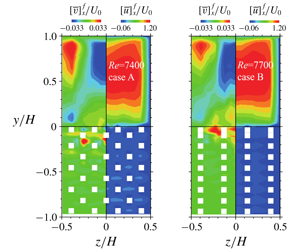Article contents
Characteristics of turbulent square duct flows over porous media
Published online by Cambridge University Press: 03 December 2019
Abstract

Particle image velocimetry measurements have been carried out to assess the fully developed turbulence in square-sectioned porous duct flows. To the bottom duct wall, this study applies two types of porous media whose porosities are approximately 0.8 and ratios of wall-normal to streamwise permeabilities are 0.8 and 7.8. Both over- and under-surface turbulence of the porous layers are discussed at inlet flow Reynolds numbers of  $Re\simeq 3500$ and 7500. Cross-sectional secondary flows are detected with an enhanced magnitude of approximately 6 % of the inlet bulk velocity. The secondary flow pattern consisting of four large vortices is observed to be insensitive to the porous structures. Over the porous wall, although turbulence is enhanced by the permeability, it is confirmed that turbulence over and under the porous surfaces is rather insensitive to the wall-normal permeability compared with the streamwise permeability as seen in porous-wall channel flows. In the present range of streamwise permeability Reynolds numbers of
$Re\simeq 3500$ and 7500. Cross-sectional secondary flows are detected with an enhanced magnitude of approximately 6 % of the inlet bulk velocity. The secondary flow pattern consisting of four large vortices is observed to be insensitive to the porous structures. Over the porous wall, although turbulence is enhanced by the permeability, it is confirmed that turbulence over and under the porous surfaces is rather insensitive to the wall-normal permeability compared with the streamwise permeability as seen in porous-wall channel flows. In the present range of streamwise permeability Reynolds numbers of  $Re_{K_{x}}=2.49{-}6.37$, the wall-normal fluctuations become dominant once underneath the porous surface while the streamwise ones become dominant again deep inside the porous layer. Applying streamwise–spanwise plane averaging, which covers a 52 % area in the middle of the duct, to the flow quantities, it is confirmed that the correlations between the pore-scale Reynolds number and the log-law parameters are similar to those seen in a wide range of porous-wall channels. The above characteristics are generally the same as those of porous-wall channels in the same range of porosities and permeability Reynolds numbers even with the enhanced secondary flows. However, from the spectral analysis of flows at the porous walls, it is found that, near the symmetry planes, the wavelengths of the Kelvin–Helmholtz waves become a little shorter than those in turbulent porous-wall channels possibly because of the sidewall boundary layers, particularly at low Reynolds numbers.
$Re_{K_{x}}=2.49{-}6.37$, the wall-normal fluctuations become dominant once underneath the porous surface while the streamwise ones become dominant again deep inside the porous layer. Applying streamwise–spanwise plane averaging, which covers a 52 % area in the middle of the duct, to the flow quantities, it is confirmed that the correlations between the pore-scale Reynolds number and the log-law parameters are similar to those seen in a wide range of porous-wall channels. The above characteristics are generally the same as those of porous-wall channels in the same range of porosities and permeability Reynolds numbers even with the enhanced secondary flows. However, from the spectral analysis of flows at the porous walls, it is found that, near the symmetry planes, the wavelengths of the Kelvin–Helmholtz waves become a little shorter than those in turbulent porous-wall channels possibly because of the sidewall boundary layers, particularly at low Reynolds numbers.
- Type
- JFM Papers
- Information
- Copyright
- © 2019 Cambridge University Press
References
- 20
- Cited by




